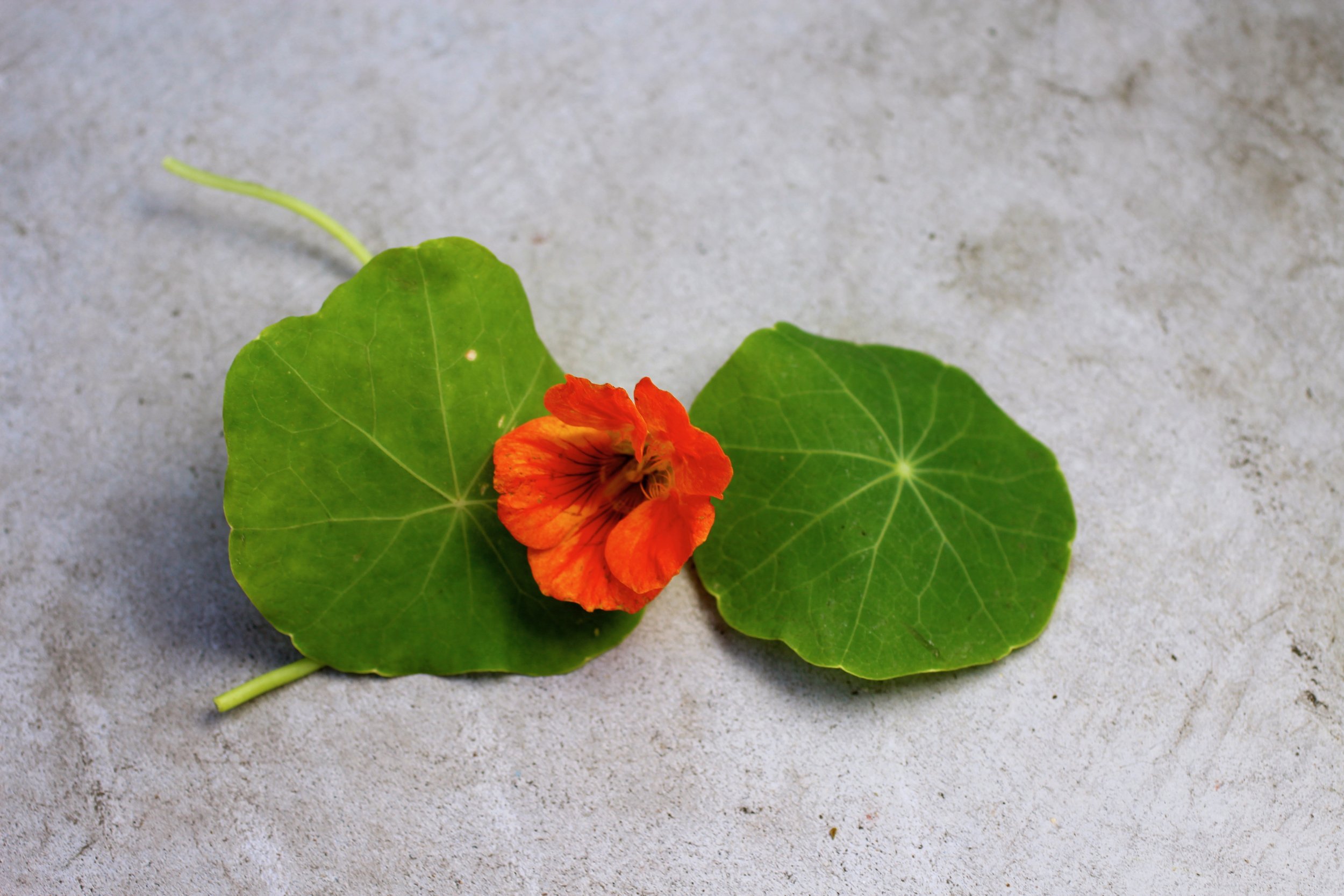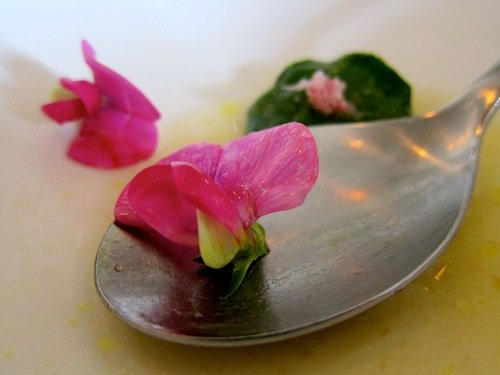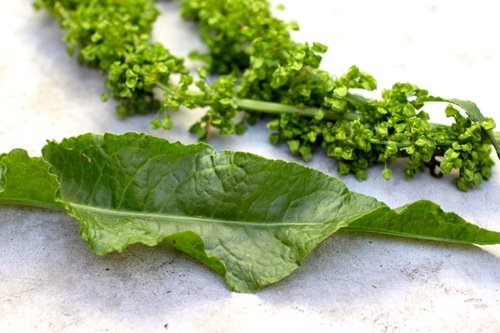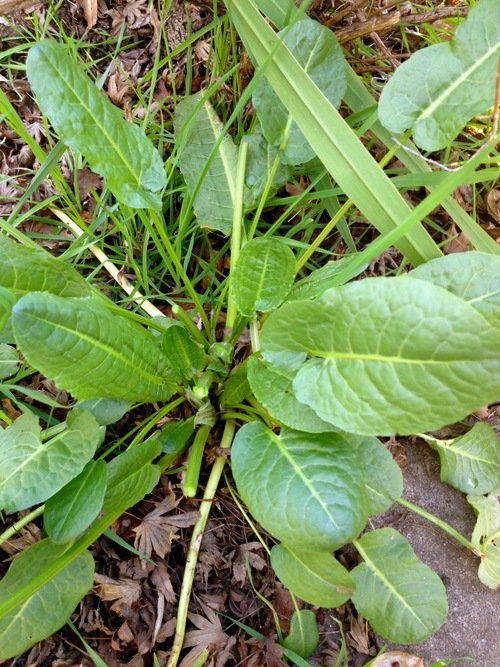Nasturtium: So much more than a (pervasive) flower
Nasturtium mezcal margaritas: An impromptu preparation for an outdoor happy hour.
Nasturtium (Tropaeolum majus) grows everywhere - everywhere - in the Bay Area as well as many other parts of the country. It flourishes in parks, gardens, and along sidewalks pretty much year-round, except when it gets very cold or very dry. The plant is sprawling and iconic - even if you do not immediately know what I am talking about, you have probably seen nasturtium many times or perhaps tasted the flowers in a salad mix from the farmers' market or restaurant. The flowers are bright orange, yellow, or sometimes red with five petals on a single stem and leaves that look similar to lily pads, but thinner. The plant comes by way of South America and my guess is that it was transported here because it is so visually appealing, grows easily, and has a tasty, unique flavor.
What I love about the nasturtium plant is that with its mustard/radish/wasabi-like flavor and cheerfully spunky appearance, it is very approachable for even the biggest wild food skeptic (as long as said skeptic doesn't have an aversion to pungency). However, when you dig a little deeper, there are so many more possibilities than just using the fresh flower as a garnish or in salads. The leaves have a slightly thick, viscous quality to them, similar to okra, but I the sharp flavor cuts this a bit and the viscosity is helpful when you want to thicken a dish, such as a risotto or stew.
Freshly picked nasturtium seed pods
Sweet pea flowers in foreground, baby nasturtium leaves in background wrapping shrimp (wish I got a better photo of the nasturtium!), rhubarb broth.
My first close and consistent experience with nasturtium was when I worked in a restaurant that used the flower to garnish mezza platters (hummus, tapenade, etc.). Being me, I would often grab a bunch of the leftover stems and take a big bite for a peppery "jolt" to keep me going throughout the night. On the other (more calculated) end of the spectrum, in the past few years I have been using the flowers in cocktails and experimenting with the leaves (either fresh in a salad or lightly cooked) and seed pods (pickling them is amazing - check out this recipe for California capers) Baby nasturtium flowers even made their way to the Noma menu when I had the opportunity to eat there and nasturtium pesto is a regular staple on the ForageSF Wild Kitchen dinners, or at least it was the few times I helped out.
Dock: Come for the leaves, stay for the seeds
Rumex crispus, or "curly dock" leaf and seeds.
Young dock leaves.
Dock, or Rumex spp. is so ubiquitous on the West Coast in the spring and summer that even if you aren't looking for it, you have probably seen it. Dock has lance-shaped, elliptical leaves that start out small and tender, but can grow quite large and tough and begin to turn yellow and/or red as they age. The two most common varieties are curly dock, Rumex crispus (pictured in this post, also known as yellow dock), and broad-leafed dock, which have characteristics that befit their names.
The leaves have a lemony taste to them that works well in a salad when they're small and tender, but are better wilted or sautéed when older and tougher. Try topping a bed of dock leaves with warm gnocchi or freshly grilled meat or adding a handful of dock leaves to a soup. A member of the buckwheat family, Polygonacaae, the seeds are similar to buckwheat seeds but not as hard. When toasted, the seeds have a slightly tart-nutty flavor similar to rye, look kind of like ants (really), and can be used in everything from granola to crackers (what I like to call, Rumex crisps) to a more realistic "ants on a log".
Dock likes to grow in urban environments - think empty lots, next to sidewalks, etc. The leaves can be found in the spring and they start to go to seed in the early summer. Even if you find dock that has gone to seed, doesn't mean that there aren't young plants still out there - the seeds will appear earlier for plants that have more sun exposure. You can eat the seeds raw, but they're much better toasted (in my opinion). Here's a recipe for toasting the seeds.
Run fingers down stem to pull off seeds. You may need to run fingers down separate smaller stems if seeds do not come off immediately.
Heat cast iron to medium-high. Add seeds and, stirring frequently, toast until they brown and give off a nutty smell, about 10 minutes. Only add seeds so that they are less than 1/4-inch up the side of the cast iron pan or less.
You are now ready to eat the seeds as a snack or use them in a recipe, such as Rumex Crisps, dock seed crackers.
Dock leaves and seeds in an array of other wild edible plants - can you find the it?
Seared onigiri (Japanese rice balls) with pickled plum

The beginnings of umeboshi made from wild California plums.
Last year I was diligent enough to get my hands on some wild plums and turn them into a California-inspired version of umeboshi, the umami-rich pickled plum condiment from Japan. You can find more about umeboshi and how I made it here, but the most important piece of information in this blog post is that as a result of my making umeboshi, I might be invited on an - I kid you not - Japanese game show. "Who Wants to Come to Japan" is a show that essentially, sends people who are interested in a particular aspect of Japanese culture and have never been to Japan and films their experience. They came across my umeboshi post and reached out to me about being a contestant. Naturally, I jumped at this opportunity. I have never been to Japan and have always wanted to go to explore Japanese foodways and the culture in general. Given it's a Japanese game show, there's definitely a high probability of ridiculousness and, although I may be the brunt of the ridicule, YOLO amiright?

Sometimes you need a little extra umeboshi paste.
So - to honor this momentous occasion (they're visiting tomorrow!) I decided to finally get around to posting my method for umeboshi onigiri, or rice balls stuffed with umeboshi paste - a delicious way to use up leftover rice! I like to sear my onigiri (technically yaki-onigiri), kind in the same vein as aracini, if you've ever had the Italian fried rice ball appetizer, but pan-seared instead of fried.
This recipe, in combination with other umeboshi dishes including asparagus with wild onion and umami and simply a corn-butter-umeboshi sauté, are so good that I am almost out of my umeboshi supply and sadly, didn't get around to pickling any this year. I guess I'll just have to savor what I have left!
The below recipe makes about 8 small onigiri and can be expanded as needed.
2 cups cooked short-grained rice (preferably sticky rice), cooled* - great way to use up your leftovers! Especially delicious is using leftover coconut rice either from a restaurant or made at home (cook rice with half water/half coconut milk).
1-2 teaspoons sesame seeds or furikake flakes (Japanese seasoning mix)
Sea salt
4 pickled plums (umeboshi), pitted and diced or smashed into a paste
Grapeseed oil, for searing
Soy or tamari sauce, optional (above photo was plain onigiri with umeboshi paste on the side)
In medium bowl, stir sesame seeds or furikake flakes into sticky rice to combine.
Wet hands lightly with water then spread a pinch of salt across your palms. Scoop 2 tablespoons of rice mixture from bowl and gently squeeze into ball. Flatten ball then form a well in the center. Add about 1/2 teaspoon umeboshi paste to well, then fold edges of rice over paste to cover.
Gently squeeze into ball then flatten again. Continue process with more rice and umeboshi until rice is gone.
Lightly oil a cast iron pan and heat on medium-high. Once oil is hot, add onigiri and sear until lightly brown, about 1-2 minutes on each side.
Serve with optional soy or tamari sauce (though you probably won't need it!)
*If rice isn't originally sticky and/or not sticky enough, you can make it "stickier" (technically, to be sticky rice, it must be a certain variety of rice that's high in a certain time of pasty starch) by heating pre-cooked rice on medium-low with 1-2 tablespoons water for about 5 minutes or until sticky, stirring occasionally. Here's a recipe for sticky rice, but I just cook rice as I always do then make it stickier after with this method.
Plum-Rosemary Jam and Spiced Chutney
One neighbor's discarded plums are another's treasure.

Preserves are a great way to preserve!
There are times that I especially appreciate how fortunate I am to live in California. Plum season is one of those times. During the months of June, July, and sometimes August, many neighborhoods in the Bay Area are literally dripping with plums. These plums are often there for anyone willing to put in the effort, as many plum tree owners can't seem to keep up with the production. While the small and tart wild plums that you can find in many parks and urban environments are lovely (especially for California wild plum umeboshi, recipe coming soon!), the Santa Rosa plums that are much-loved cultivated variety in the area are pretty ethereal. They are sweeter, but not cloyingly so, with beautiful flesh and an almost rose-like scent. When my neighbors told me that they had more of these plums than they could handle and told me to take as many as I could I knew I hit the plum jackpot. Low hanging fruit for sure!

I gotta lotta neighbors with a lotta unused plums.
There are many ways to enjoy plums like use them in place of apricots in this ginger almond galette or simply eat them fresh and let the juices run down your chin, but if you're in need of putting up (isn't that a great phrase?) a lot of them for later use, preserves (hence the name) are a classic way to go. When I have a bunch of fruit, I like to make both jams and chutneys because it's nice to have a classic jam for topping toasts and yogurt, filling pastries, and making cocktails, but chutney is great to have around for savory applications. Serve it with blistered green beans or roast chicken eh, voilà! All of a sudden that ho-hum dish is exciting. The jam uses store-bought pectin - I used to only make my own pectin from citrus pith, but (although fun) it can be quite time consuming and the Pomona pectin is a faster way to success. The quantities and spices in both the jam and the chutney are adaptable to availability and preferences!
Plum-Rosemary Jam
Makes about twelve, 8-ounce jars. Recipe adapted from Serious Eats.

Glorious Santa Rosa plums.
6 pounds plums, pitted and chopped
2.25 pounds granulated sugar
1.5 Tbs Pomona's Universal pectin or other low-sugar pectin
2 Tbs calcium water (comes in pectin package)
2.25 ounces lemon juice (about 2 lemons)
3 sprigs rosemary
Toss plums with sugar and pectin in large bowl. Cover, refrigerate overnight (optional - this may be helpful if you don't have time to make jam after picking fruit and want to save it until the next day).
Put two spoons in the freezer.
Heat in large pot on medium with calcium water, lemon juice, and rosemary sprigs, stirring frequently. Cook for 30 min - 1 hour, skimming off foam* and smashing to desired texture. An immersion blender can also be used to break down fruit, but rosemary sprigs should be removed before blending.
Check for doneness by putting jam on spoon and putting back in freezer for 2 minutes. When you run your finger through the jam on the spoon, it should leave a track and jam should cling to the spoon (rather than running off). The jam in the pot will also be a lot glossier/smooth.
While jam is cooking, wash and sterilize jars and rings by submerging under water and boiling for 10 minutes. Throw in the lids once they’ve boiled for 10min and turn off water.
Remove rosemary sprigs and fill jars, leaving 1/2 -inch headspace. Screw on rings loosely, submerge again in water for another 10 minutes to seal.
Store at room temperature. Jam is good for up to 1 year.
*The foam is tasty and has a cool texture, kind of like meringue! Next time I do this, I want to blend into egg white foam and see if it will set up into a cookie, but is great and fun on desserts regardless.

The flesh is yellow in color and the taste tart-sweet. Cut around the pit, as it does not fall out willingly.
Spiced Plum Chutney
Makes about four, 8-ounce jars. Recipe adapted from Jamie Oliver (with a lot more kick added!)
2.2 pounds plums, pitted and chopped
4 shallots, thinly sliced
1 tablespoon neutral oil (grapeseed or vegetable)
3 fresh bay leaves
7 cloves
9 allspice seeds
1 tablespoon black or yellow mustard seeds
1 tablespoon coriander seeds
2 teaspoons red pepper flakes (optional - this amount is pretty spicy)
1-3/4 cups brown sugar
3 tablespoons grated ginger
Zest from 1 large orange
Juice from 1 large orange
300ml cider vinegar or 200ml red wine + 100ml water
1/2-1 teaspoon salt

Cook shallots in oil on low until golden.
Add bay leaves and all spices except for ginger and sauté for 1 minute.
Stir in plums. Add sugar, ginger, and orange zest. Squeeze juice from orange into measuring cup, top off with cider vinegar or vinegar/water combination until it reaches 450ml. Add this to plums and bring to a boil. Simmer until thick about 30 minutes - 1 hour. Salt to taste.
While chutney is cooking, wash and sterilize jars and rings by submerging under water and boiling for 10 minutes. Throw in the lids once they’ve boiled for 10min and turn off water.
Remove bay leaves and as many allspice seeds as you can and fill jars, leaving 1/2 -inch headspace. Screw on rings loosely, submerge again in water for another 10 minutes to seal.
Store at room temperature. Chutney is good for up to 1 year.

To label jam, I use old paper grocery bags - just trace the outside of a ring, cut out a circle slightly smaller than the outer edge, and then screw on top of the lid.

Phases of plum.
Elder Almond Pound Cake
Elderflower and elderberries unite for a perfect taste of summer, in all its glory.
This nutty loaf cake uses both elderflower cordial and elderberries for the complete elder experience. Cordial can be substituted for any sweet syrup and elderberries for other berries, if you only happen to have one of the gifts from the elder tree on hand. The time for harvesting elderflower in the Bay Area is May through June/July and elderberry season is July through September. See related the Regal Elderlflower article for information on the elder tree and harvesting elderflower - more information on harvesting elderberries will be available soon as July approaches! Serves 8.

Elderflower
Harvest May - July.

Elderberry
Harvest July - September.
3/4 cup unsalted butter, room temperature
3/4 cup granulated sugar
4 eggs
2 tablespoons plain yogurt
6 tablespoons elderflower cordial (see Edible East Bay Summer 2016 issue for recipe or use St.Germaine or any other sweet syrup), divided
1 cup all-purpose flour
3/4 cup almond meal
2 teaspoons baking powder
3/4 teaspoons salt
2 cups fresh elderberries, washed and dried (may be previously frozen, can use other berries if needed)
1 cup whipped cream or crème fraîche (optional)

The line of elderberries in this pound cake is delicious as it is visually appealing.
Grease one 9 by 5-inch loaf pan (or 4 mini loaf pans) and preheat the oven to 350 degrees F.
Cream the butter and granulated sugar until they are light and fluffy. Beat in the eggs one at a time then incorporate the yogurt and 3 tablespoons of the elderflower cordial.

Wait for a golden crust and clean toothpick.
In a separate bowl, mix together the flour, almond meal, baking powder, and salt and slowly whisk this into the wet mixture until incorporated. Pour half of the batter into the greased loaf pan(s). Toss elderberries with remaining 3 tablespoons elderflower cordial and spread evenly over the batter in the loaf pan(s), followed by the remaining batter. Bake for 1 hour or 30 minutes if using the mini loaf pans. Cake is done when top reaches a golden brown and a toothpick comes out clean. Remove from oven and allow to cool.
Remove cake(s) from loaf pan(s), slice into pieces to reveal berry layer, and serve with optional whipped cream or crème fraîche.

Mini loaf pans or a standard 9x5-inch loaf pan can be used. Serve with whipped cream or crème fraîche (optional).
Chicken & greens Saltimbocca with Brandied Cherries & sage
A unique spin on weeknight chicken.

Brandied cherries are a great complement to the savory chicken and prosciutto.
I have to admit that pounding boneless, skinless chicken breast into a thin sheet and rolling it up with other ingredients isn't something I would have come up with on my own. In fact, I pretty much never buy boneless, skinless chicken breast because it seems like a waste of flavor and texture, but this "transformed saltimbocca" (saltimbocca is traditionally made with veal and prosciutto, rather than chicken and prosciutto) is a great way to rethink chicken dinner and the ingredient combinations are endless. In this version, I used house brandied cherries (so fun to incorporate them into something savory!), spinach, and sage, but other possibilities that have come to mind include: Mashed butternut squash + black olive, gruyere + thyme, parsley + coriander + lemon zest, or even tatsoi + sesame + miso - as you can see, really endless possibilities! A little bit of sweet is nice in any combination, as it pairs nicely with the savory qualities of the chicken and prosciutto. Although the preparation may seem complicated, once you get the hang of it, it's really simple and the actually cooking time is very quick. Below recipe makes 2 generous portions or 4 smaller portions.
2 boneless, skinless chicken breasts (about 1 pound)
Salt and freshly ground black pepper
4-8 thin slices of prosciutto (depending on size, see below)
About 20 fresh sage leaves, divided
1.5 cups fresh spinach
1 tablespoon olive oil, plus more for drizzling
3/4 cup chicken broth
1/4 cup dry white wine
3 tablespoons brandied cherry juice
4-8 brandied cherries (2 per serving)

Chicken cutlets layered with prosciutto, sage, and spinach before rolling up.

A meal of chicken brandied cherry saltimbocca, broccolini, and of course, wine.
Cut chicken breasts in half lengthwise to create 4 pieces and pound using a meat pounder or rolling pin to evenly flatten - pieces should be about 1/4-inch thick. If using a rolling pin, cover chicken with plastic wrap before rolling to prevent cross-contamination.
Sprinkle chicken with salt and ground pepper and lay one slice of prosciutto on each piece of chicken (use more than one piece of prosciutto to cover chicken if needed) followed by 3 leaves of sage per chicken cutlet. Reserve remaining sage leaves.
Heat a skillet on medium-high heat and briefly toss spinach with a drizzle of olive oil and a sprinkle of water. Cook just to wilt, remove from heat, season with salt and pepper, and chop. Arrange spinach in an even layer over the prosciutto slices.
Beginning at the tapered end, roll up each chicken cutlet like you’re rolling up a cinnamon roll. Secure with a toothpick.
Chop 4 of the remaining sage leaves. Heat the tablespoon of oil in a dutch oven or deep skillet on high heat. Cook the chopped sage and chicken rolls until golden brown, about 2 minutes per side. Add the chicken broth and wine and scrape browned bits off bottom of pan with a wooden spoon. Bring liquid to a boil then reduce heat to medium, cover, and simmer until chicken is cooked through, about 8-10 minutes.
Transfer chicken to a platter and remove toothpicks. Continue simmering cooking liquid with 3 tablespoon brandied cherry juice over high heat until it is reduced to about 1/3 cup, or 5-7 minutes then toss in brandied cherries. Drizzle the reduced cooking liquid over the chicken. Serve on top of polenta or other starch with sage leaves and brandied cherries as garnish.

Polenta pairs well with saltimbocca because its soft, simple nature.
Classic Elderflower Cordial & Elderflower berry birthday cake
Bring the spring to any beverage or dessert.

Any search for the culinary uses of elderflower will pull up elderflower cordial. By cooking the flower head in what is essentially a diluted simple syrup, you can pretty easily preserve its fragrance for future use. Which is great, because elderflower is an amazing, special plant that deserves to be savored. The most common way to enjoy elderflower cordial is by using it in cocktails (gin, elderflower, and lemon, is a tasty simple classic) or adding a bit to sparkling wine or even sparkling water for a nice kid-friendly afternoon refreshment. I also love drizzling elderflower cordial over any dessert for a quick and easy way to make that dessert oh-so-special (such as for my huckleberry-elderflower birthday cake below).
Elderflower cordial: Makes about 1 liter.
20 medium elderflower heads (about 2-3'' across)
Grated zest of 2 lemons
Juice of 2 lemons
4 cups water
3.5 cups sugar
Note: Some recipes call for citric acid (about 1 teaspoon for this batch), which helps the cordial keep for longer.

Infusing water with elderflower essence.
Inspect the elderflower heads carefully and remove any insects. Remove flowers from most of stems (especially the large ones), wash by quickly submerging in cold water, and drain. Place the flower heads in a large bowl together with the lemon zest.
Bring water to the boil and pour over the elderflowers and citrus zest. Cover and leave overnight to infuse.
Strain the liquid through cheesecloth and pour into a saucepan. Add the sugar and the lemon juice. Heat gently to dissolve the sugar, then bring to a simmer and cook for 2-3 minutes.
Use a funnel to pour the hot syrup into sterilized bottles and seal with a sterilized cap or cork. Bottles can be sterilized by washing with soapy water then plunging into boiling water for 5 minutes and allowing to air dry.
Allow to cool then store in the refrigerator or freezer. Cordial will keep in the fridge for 2 weeks and in the freezer for 1 year. I like to freeze the cordial in smaller batches so I can use it as needed.
Elderflower-Mulberry Birthday Cake: Serves 12.

Bottom half of the cake has been drizzled with cordial and is about to be spread with tart whipped cream.
For my birthday last weekend, I had an inkling to make a cake infused with elderflower cordial, but had a hard time deciding exactly what else to include - apricots and almonds? loquats and honey? lemon and poppyseed? Spring is a fun time to daydream about desserts! While walking through my surprisingly abundant neighborhood however, I was lucky enough to stumble upon some mulberries, which helped to complete my vision. My birthday party was a campout and the cake held up nicely for several hours, even though I was impatient and made the tart whipped cream earlier than necessary:) My photos do not show the final spread of whipped cream on the top, as it was too dark for photos when I added this piece.
1/2 cup plus 5 tablespoons unsalted butter, room temperature
3/4 cup plus 2 tablespoons granulated sugar
4 eggs
2 tablespoons yogurt
3 tablespoons plus up to 3/4 cup elderflower cordial
1 cup all-purpose flour
1/2 cup almond meal
2 teaspoons baking powder
3/4 teaspoons salt
2 cups fresh mulberries, washed and dried
3/4 cup whipping cream
1/2 cup crème fraîche
1/2 teaspoon vanilla extract
Grease a 9-inch springform pan and preheat the oven to 350 degrees F.
Cream the butter and 3/4 cup sugar in a mixer until they’re light and fluffy. Beat in the eggs one at a time then incorporate the yogurt and 3 tablespoons of the elderflower cordial.
In a separate bowl, mix together the flour, almond meal, baking powder, and salt and slowly whisk this into the wet mixture in 3 batches. Once its fully incorporated, pour half of the batter into the greased springform pan, then spread mulberries evenly over the top, followed by remaining batter and bake for 1 hour. Cake is done when a toothpick comes out clean. Remove from oven and allow to cool.
While cake is baking, beat whipping cream until almost stiff, continue beating as you add in 2 tablespoons sugar and vanilla and then lightly whisk in crème fraîche.

The gorgeous mulberry layer is revealed!
Once cake has cooled, cut in half to make two layers using a large serrated knife. You should be cutting right through the berry layer and at this point, you will be able to see all of the beautiful mulberries hiding inside.
Drizzle up to 1/4 cup of elderflower over the bottom layer and top with half of the tart whipped cream, followed by the other half of the cake. Drizzle up to another 1/4 cup of elderflower (for both of these, it depends on how sweet/moist/elderflowery you want the cake) and spread the other half of the whipped cream over the top. Top with a sprinkling of fresh elderflowers if you have them and drizzle each piece of cake with a little more elderflower cordial before eating.

This version is before the addition of the final tart whipped cream layer.
The Regal Elderflower
A fragrant pagan declaration of summer.

Processing elderflower for fermented cordial with the Nordic Food Lab crew. We were all covered in pollen after this flower-plucking session! Species of elder likely Sambucus nigra.
There's something truly special about the elder, or Sambucus, plant and I've always felt a special connection to it. Not only does it proclaim to the world that summer is approaching and provide culinary and medicinal benefits, but it also somehow manages to be both utterly wild and elegantly refined at the same time. The plant is likely called "elder" because it is so old that you can find varieties of it around the world. It's no surprise then that so many cultures have different symbolisms and uses attached to Sambucus including (but definitely not limited to) the below.
Symbolism
Shakespeare: Grief (the "stinking elder"), yet also beloved
Pagan: Superstitions around cutting it back or burning it (will cause bad luck)
Danish: The elder Mother or "vegetation goddess" lives in the tree (HyldeMoer) - you need to ask her permission before cutting it.
Sicilians: Kill serpents and drive away robbers
Serbians: Good luck if used during the wedding ceremony
England: Hold in pocket to ward off lightning, cross above animals to ward off evil
Supposed Medicinal Uses (Note: I have not looked into the scientific evidence supporting any of the below, but rather wanted to show the breadth of supposed medicinal uses)
Bark: Purgative, emetic, diuretic, asthma (not consumed anymore due to toxins)
Leaves: Bruises/sprains, wound healing, expectorant, diuretic (not consumed anymore due to toxins)
Flowers: Tea for swollen sinuses, colds, flu, diabetes, constipation, rheumatism, influenza, relaxant, complexion, blood purification
Berries: Hot wine for influenza, asthma, juice for antiviral/antibacterial
Food
Flowers: Cordial (St.Germain is an elderflower liqueur), desserts, jelly, shrub, fritters
Berries: Cordial, wine, syrup, desserts, jelly, etc.
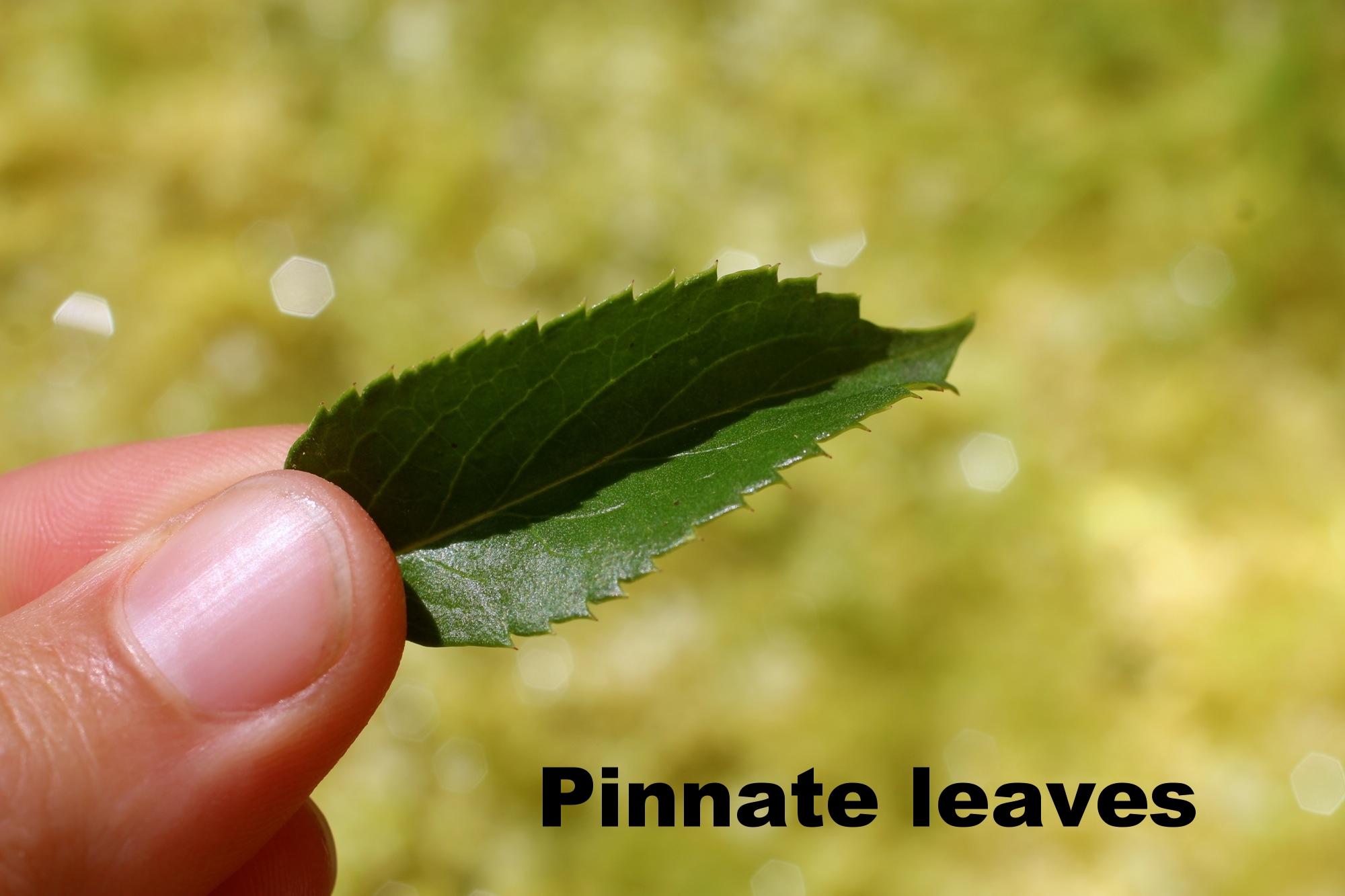
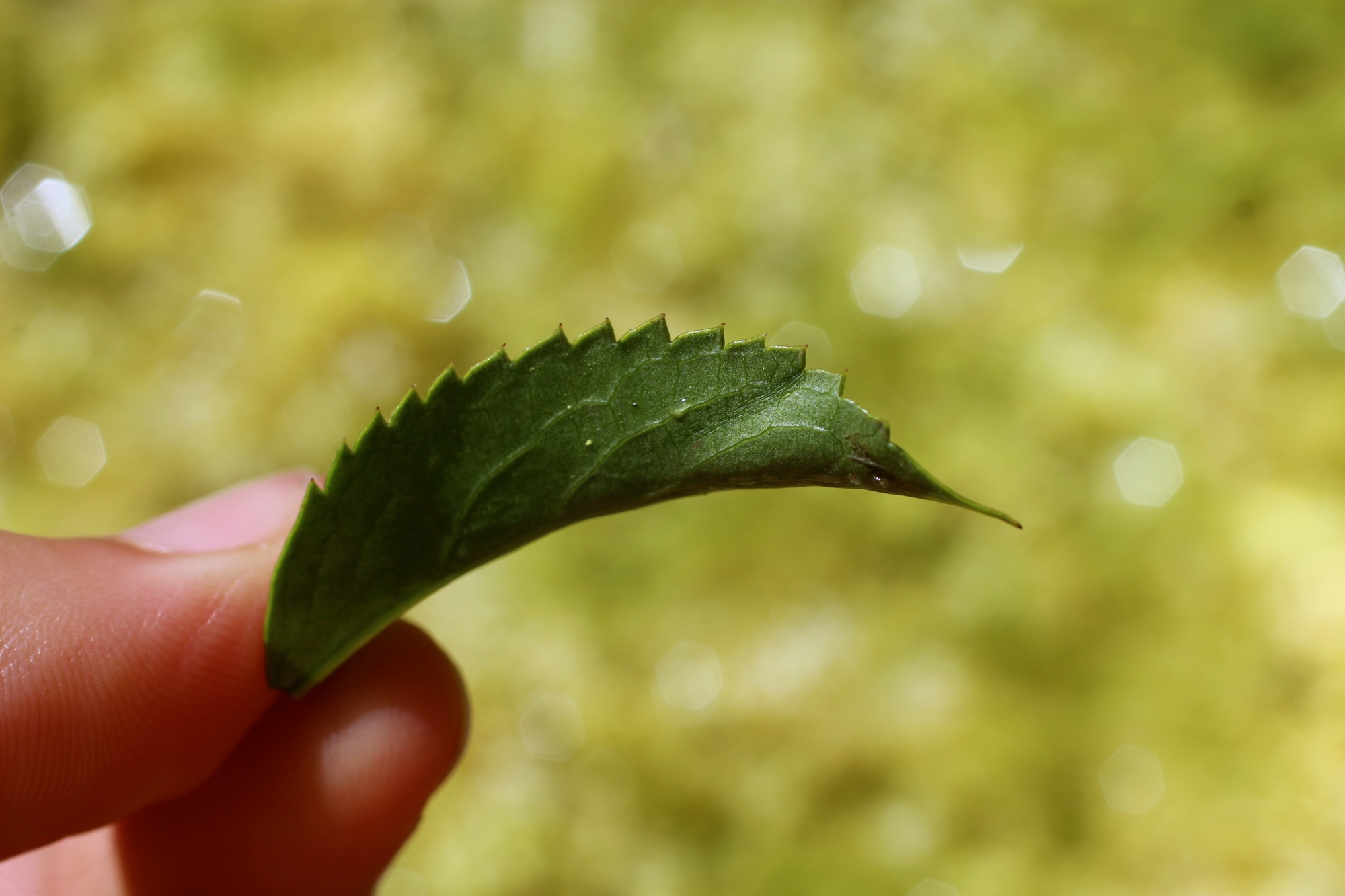
The elder tree can grow up to 25 feet tall and has reddish bark and pinnate leaves opposite of each other. The tiny star-shaped flowers, which bloom in May/June, are a yellowish white/cream color and grow in clusters. The elder plant that you will find in Northern California (and most of the Western United States) is Sambucus cerulea, also known as blue elder for it's dark blue berries. The berries can be found later in the summer, are a bluish/black often with a whitish powder sheen and also grow in large clusters.
ELDERFLOWER AND ELDERBERRIES MUST BE PROCESSED BEFORE CONSUMING. Don't just go around grabbing handfuls and consuming them raw like you would blackberries! However, the berries may be fine in small amounts and both berries and flowers are definitely safe after cooking or drying. When using the flowers, such as in this elderflower chive fritter recipe, it's best to remove as much of the stem as possible, but some stem is fine if cooked.

Notice tiny star-shaped flowers. This Sambucus nigra from Europe has larger clusters and whiter flowers than the Sambucus cerula of California.
My first experience with elderflower (other than St.Germain) was during my stint as a visiting researcher at the Nordic Food Lab in Denmark. We spent a morning riding all over Copenhagen to forage huge clusters of elderflowers and stuffing them into sacks before plucking the flowers to be used in a fermented cordial. I still fondly remember being covered in pollen afterward while enjoying a well-deserved chocolate rye roll. Denmark is really a magical place and elderflowers unsurprisingly about there. The elderflowers you find in Denmark are most likely to be Sambucus nigra rather than the Sambucus cerulea that is found in California and are a bit larger and whiter, but both have the same beautiful fragrance and uses. As I left Denmark before the berries came out and just recently found a spot for elder in California, I have yet to experiment with the berries, but am greatly looking forward to doing so this summer!

Yellower, yet still star-shaped, flowers of the Sambucus cerula foraged from Tilden Park in Berkeley, CA.
Lamb Shank with Spruce Tips, Juniper, and Pink Peppercorn
Spring lamb gets a Nordic makeover.

Bright young spruce tips.
My time at the the Nordic Food Lab taught me that not only are pine, spruce, and fir tips edible, but that they are surprisingly delicious if harvested in the spring when young and still soft. I have every intention of gathering all three to post on identification and flavor subtleties, but until then, here's a helpful article. Just know that if you come across a "Christmas tree" in the spring with delicate, very bright green tufts of soft needles on the end of its branches (see photo to right), you have likely come across spruce or fir tips (pine needles are longer). Take a teeny tiny bit of a needle and give it a taste - it should taste tart and slightly resinous. If you've ever had the Greek retsina wine you will know exactly what I mean.

Spruce tips pushing through their brown papery casings.
What I love about spruce tips is that they are so very seasonal that anything you use them in has a uniquely spring flavor and color. At Noma, the restaurant that many consider the best in the world, uses these fresh conifer needles in variety of ways and I specifically remember a fermented apple beverage infused with pine that was amazing. Additionally, they're very rich in Vitamin C and can be dried and used for a throat soothing tea. The flavor may not be to everyone's liking, but if you like it then you love like it and the tartness can really make other deeper flavors pop, as they do for this rich lamb shank recipe adapted from Cooking with Italian Grandmothers. I recently purchased a quarter of a lamb from Devil's Gulch Ranch, as I have done a few other times, and am always happy to have an excuse to make lamb in a variety of new, fun ways. Recipe makes enough for 2, but can be expanded.
1 cup dry red wine
1 large lamb shank or 2 small (about 1.5 pounds total)
Salt and freshly ground black pepper
1-2 tablespoons olive oil
1/2 large red onion, thinly sliced (about 1-1.5 cups)
2 cloves garlic, minced
1/2 cup finely chopped celery (about 1 rib)
5 juniper berries, finely crushed with a mortar and pestle
1 tablespoon tomato paste
Water as needed
1 bay leaf (I used a foraged bay leaf, which imparts a stronger flavor)
1/2 tablespoon fresh lemon juice
2 teaspoons whole pink peppercorn, crushed with fingers
7-9 fresh spruce tips, stems removed from most
Preheat oven to 350 degrees F. Bring wine to boil in a sauce pan. Reduce heat and simmer until wine is reduced in half, about 7 to 9 minutes. You should have about 1/2 cup - if you don't, just add a bit more wine and reduce again to get 1/2 cup. Set aside.
Season lamb shank generously with salt and pepper. Heat a heavy oven-safe pot over medium-high heat. Add 1 tablespoon of olive oil. Once oil is hot, brown lamb shank on all sides and transfer to a plate.
Reduce heat to medium and sauté onions with a little salt until just softened, 5 to 7 minutes, stirring occasionally. Add garlic, celery, and crushed juniper berries and cook for another 5 to 7 minutes.
Add reduced wine, 1/3 cup of water, tomato paste, and bay leaf and stir, scraping up browned bits. Return lamb and any accumulated juices to the pot and bring to boil. Remove from heat, cover with lid and place in oven. Braise for about 1-1.5 hours, until meat is almost tender.
Finish cooking on the stovetop over low heat for about 1/2 hour. If sauce is too liquid, leave the lid slightly ajar so it will reduce. Conversely, if it gets too dry, add water, a little at a time. Remove from heat. Stir in lemon juice and transfer to individual plates or a serving dish. Top with crushed pink peppercorn and spruce needles and garnish with a few whole spruce tips.

Fennel, Fennel Everywhere
Abundant sweet anise flavor.
“Note: we’re currently gathering samples in the most industrial soils we can find to measure potential toxins - if the plant tissues from these soils haven’t accumulated toxins, pretty much any urban soil will be safe. More on that later! ”
Whether you've been looking for it or not, you likely come across wild fennel, or Foeniculum vulgare, quitefrequently. On a recent sample gathering in West Oakland, I was once again struck by just how rampantly wild fennel grows. Asphalt, cement, roadsides, or parking lots, wild fennel survives and thrives everywhere.

Feathery leaves of wild fennel fronds.

Foraging wild fennel in a North Oakland median.
A member of the same family as carrot, parsley, and dill, fennel has thin feathery leaves that connect to a larger stem. The plants can grow very tall and may have delicate yellow flowers. On foraging walks, I always get very hopefully asked about how to harvest the fennel bulb, but alas, wild fennel does not have a large bulb as you find with conventional fennel. Fortunately, the leaves are incredibly abundant and flavorful, as are the stalks, and flowers, pollen, and seeds in season. Fennel often grows alongside poison hemlock, which is in the same family, but has leaves more like carrot tops and purple splotches on the stems. If you are unsure if what you have is fennel, give it a smell - the smell will undeniably tell you if you have fennel. You can find fennel primarily in the spring through early fall, though I have seen it at all times of the year, and the flowers and pollen can be found in the summer.
Although you probably wouldn't want to make an entire salad of fennel, the sweet anise and licorice flavor works great as a garnish. Try it in sauces, on fish or chicken, in soups, in omelettes, desserts, and as a salad component. The pollen is lovely as a tasty condiment and the seeds are a digestive aid.

When in doubt - smell the plant and if it's fennel, it will definitely smell like fennel.
The below is NOT FENNEL, but POISON HEMLOCK. Note the carrot-like leafy tops and purple splotches on the stem. The poison hemlock flowers are similar to fennel so be sure you carefully determine what you're picking and identify the fennel by the feathery, thin leaves and smell.

Photo credit: http://www.kingcounty.gov/
Cherry and Wild Fennel Clafoutis
The easy dessert that doubles as breakfast!

Sometimes, a word for a dish or a food preparation method I have never used will come to me and I will not rest until I have experienced it. That is what happened with "clafoutis" - I have no idea where I was introduced to the word, but after we picked up some cherries on our way back from a wedding in beautiful Los Olivos, all I could think about was making a cherry clafoutis, while at the same time asking myself, "cherry clafoutis is a thing, right?" This is where the internet came in, helpfully proving that cherry clafoutis is, indeed, a thing and although I don't necessary need a reason to make special desserts, my mother was serendipitously visiting for Mother's Day. Using a recipe from Saveur as a base, I decided to decrease the egg because some comments complained of eggy-ness and I tend to shy away from really eggy desserts and include wild fennel (more on wild fennel including foraging here), as cherry and fennel go together in a delightful way.
There are a few great things about this dessert. The first is that it's easy - really easy. It's also visually impressive in the cast-iron pan and versatile in ingredient options (apricot + almond? pear + bergamot?) and, because it's not super sweet, it's also versatile in potential eating occasion. We enjoyed it with fennel whipped cream as dessert and again the next day with coffee for brunch and I'm pretty sure no one would turn their nose up to a clafoutis at tea time. So, now you have no excuse - get out there, forage some fennel (which is all over the bay area), buy some cherries, and make this deliciously easy puffed crepe-like cake! Recipe below serves 8.
“Cherries can also be unpitted, which provides a more rustic flavor and texture, but I did not this time, as I knew my mom wouldn’t like it!”
1 cup chopped wild fennel fronds, plus a few fronds for garnish
1/2-1 cup whipping cream, depending on how much your group likes whipped cream (optional)
7-8 tablespoons sugar, divided
1 tablespoon plus 1/2 teaspoon vanilla extract, divided
1/2 tablespoon butter
1-1/4 cups whole milk (can be substituted for a combination of 3 parts reduced fat and 1 part whipping cream, if you happen to have these around like I did)
2 tablespoons kirsch or Luxardo (I had Luxardo, but think it would be better with kirsch)
5 eggs
1/2 teaspoon medium coarse Kosher salt, divided
3/4 cup all-purpose flour
3 cups black or sour cherries, pitted (see post on how to pit cherries like a boss)
Confectioner's sugar, for dusting

Infuse whipped cream with wild fennel by allowing whipping cream to impart fennel flavor overnight.
To make fennel whipped cream: Place 1/2 cup chopped fennel in a mason jar, pour whipped cream over top, cover, and refrigerate overnight. Remove fennel then beat cream until whipped, adding 1-2 tablespoons of sugar and 1/2 teaspoon of vanilla toward the end of beating. Refrigerate until used.
Heat oven to 425 degrees F. Grease a 9'' cast-iron skillet and set aside. Whisk milk, sugar, kirsch or Luxardo, vanilla, eggs, and 1/4 teaspoon salt until combined. Add flour and whisk until smooth, about 30 seconds.
Pour batter into buttered skillet, then distribute cherries evenly over top. Bake until a skewer inserted into batter comes out clean and a golden brown crust has formed on top and bottom of clafoutis, about 25 minutes. Dust with confectioners' sugar and serve with a dollop of fennel whipped cream, if desired.

The Schoolyard cocktail
Gin, wild chamomile, and lemon.

As I mentioned in another post with more general information about wild chamomile, I used to smell and sample wild chamomile (Matricaria discoidea), otherwise known as "pineapple weed" on the schoolyard, hence the name for this drink. Now I forage it where I can (which is pretty much everywhere in the spring and early summer), wash it, and make a wild chamomile simple syrup with it to be used in cocktails. I played around a bit with this cocktail, including other liquor such as Salers or adding grapefruit bitters, but ultimately it was best to let the wild chamomile syrup shine by keeping it simple. Recipe below is for one cocktail.
1.5oz gin (Bar Hill gin or St.George Terroir would both be good choices)
0.5oz meyer lemon juice
Pineapple weed for garnish
Shake and serve up with pineapple weed flower.

Wild Chamomile Simple Syrup
Cocktail flavor from between the cracks.

Wild chamomile, or pineapple weed grows almost everywhere and is very distinctive.
Wild chamomile, Matricaria discoidea, has a wonderful fragrant aroma that makes for great cocktails. Learn more about this edible weed here. One simple way to incorporate the flavor into cocktails is by infusing a simple syrup with the flowers and leaves of the weed. Not only is this syrup fantastic in cocktails, such as The Schoolyard, but it's also lovely in lemonade, ice tea, drizzled over ice cream (or made into ice cream or gelato), cakes, tarts, etc. Below recipe is for about 1 cup of simple syrup.
1 cup washed pineapple weed flowers and tops of leaves: Flowers can be removed from the weed using scissors, some of the top leaves around the flowers are okay, but you want to make sure it's mostly flowers.
1 cup sugar*
1 cup water
Combine sugar, water, and pineapple weed in a small heavy saucepan.

Use scissors to easily cut off pineapple weed flowers and leaves.
Bring to a simmer, stirring occasionally, for 5 minutes. Remove from heat. Let the syrup cool completely, then squeeze as much juice as possible from flowers, pour through cheesecloth into a jar or resealable container. Simple syrup will last 1 month refrigerated.
*You can also make a 2:1 (sugar: water) simple syrup that will last up to 6 months refrigerated. This 2:1 syrup is sweeter than most, so you will need to add less to recipes.

Wild Chamomile: Tasting Between the Cracks
Matricaria discoidea.

Wild chamomile aka pineapple weed is easily uprooted from the ground.
In a way, I was foraging before I even knew what it meant. The schoolyard of my childhood did not have much grass. Okay, it didn't have any grass at all. When we weren't scraping our knees on the pavement playing football or foursquare, we were investigating whatever we could find poking out from the cracks in the pavement. I specifically remember a "game" we had with one weed in particular: Matricaria discoidea, or "pineapple weed" or “wild chamomile”.
“Luckily, there wasn’t any poison hemlock growing from the cracks, though something tells me our intuition would keep us away from it. ”
The game went like this: I would instruct a schoolmate to envision any fruit of their choosing, then would have them smell the pineapple weed flower as I crushed it under their nose and voilà!, smell like that fruit it would. Sometimes I would also take a taste of the (strawberry, cantaloupe, grape, orange...) smelling fruit and, to my surprise, it also tasted like that fruit. Now, I'm not condoning tasting something that you have not identified, but it's fun to think that even young children can find food in a desolate landscape.
“Between its unique look and distinct, fragrant aroma it is pretty easy to identify and can be found in the spring/summer in gardens, on trails and yes, even in cracks in the sidewalk.”
Like chamomile, wild chamomile can be dried and made into a tea and is in the Asteraceae family, which is the same family as daisy, dandelion, and thistles. It grows low to the ground, has thin, feathery, branching leaves and small yellow cone-shaped flowers that resemble a tiny pineapple.

Abundant pineapple weed at the Peralta Community Garden - the members had no problem with my taking as much as I wanted.

Harvested wild chamomile.
On a recent visit to the Peralta Community Garden in North Berkeley for a wild food talk there was massive amounts of pineapple weed that the gardeners gladly let me pillage. I turned my bounty into a stock of wild chamomile simple syrup that is great in cocktails, lemonade, or for drizzling on pancakes. Other uses include scattering on salads, fish, chicken, or fruit tarts. I may have originally "discovered" this weed in childhood, but it's great to come back to it as an adult!
Bouillabaisse with wild fennel
Classy and quick, the seafood stew of seafood stews.

My mother wasn't a typical Martha Stewart-like homemaker (sorry, mom), but she did have a few tricks up her sleeve and one of them was bouillabaisse (another was making things magical, but we're not going there right now). I grew up in a fish-loving area of Northern California and, even with a limited budget, we were able to get good, super fresh, seafood regularly. Bouillabaisse was one of those dishes that we requested for birthdays, made for special occasions, and always got excited about because it meant "special". As time moved on, we grew up and had more disposable income, which allow for a crab leg here, better fish there, and even an infamous (gasp) lobster tail on one occasion. These variations taught me about the adaptability of bouillabaisse, which I take with me when I prepare it now, adding shellfish and fin fish as available. The version below also includes a dash of Pastis, the anise-flavored liquor favorite from the south of France. Serves 4-6, preferably with crusty french bread or toasted crostini to mop it up.

1 tablespoon olive oil
A few wild fennel stocks and fronds (can substitute store-bought bulb/fronds)
1 medium yellow onion, chopped
3 cloves garlic, thinly sliced
2 cups fish stock
1.5 cups dry white wine
1 pound rock cod or other firm white fish
1 pound medium to large shrimp (I prefer with the peel)
14 ounce can diced tomatoes
1 pound fresh clams
2 tablespoon pastis, such as Ricard
1/2 teaspoon salt
1/2 teaspoon coarse ground black pepper
Chopped parsley for garnish
Dice the fennel stalks to yield ~1/4-1/2 cups. Pluck fronds and set aside for later use.
Heat the oil in a large pot over medium-high heat. Add the fennel stalk, onion, and garlic. Cook, stirring occasionally, until slightly tender, 3 to 4 minutes.
Add the fish stock and wine and bring to a boil. Add the rock cod, shrimp, and tomatoes and cook, covered, for 3 minutes.
Add the clams and cook, covered, until the cod and shrimp are cooked through and the clams have opened, 3 to 5 minutes.
Stir in the pastis, salt, and pepper. Sprinkle with the parsley and garnish with fennel fronds before serving.

Wanting the Unwanted: Why Eat Weeds
Wild food week 4/4 - 4/10!

What is the first food that comes to mind when you hear "foraged"? My guess is that a mushroom came to mind. While it's true that most mushrooms are grown in the wild, there's an abundance of other wild plant foods that are much easier to find and identify.
Just because these wild plants are out there, does that mean we should eat them? My colleagues and I of Berkeley Open Source Food (BOSF) are arguing yes. Here's why:
Nutrition:When the human diet shifted from hunting and gathering to agriculture some 10,000-20,000 years ago, we began the process of selecting certain monocultures for specific characteristics. Decreasing agricultural diversity had benefits, including population growth, but also led to a decrease in a variety of nutrients, particularly phytonutrients, causing the Western diet to have a much narrower range of nutrients today than it did thousands of years ago. These phytonutrients may reduce our risk for modern chronic diseases such as diabetes, heart disease, and cancer. Incorporating more wild foods into our diet might help reduce the risk of chronic disease.

Ubiquitous snack: the humble dandelion
Sustainability: It's no secret that California is experiencing a massive drought. These wild plants require no water beyond what nature provides, are largely drought-resistant, and are abundant in urban environments. Additionally, if we can make it profitable for farms to harvest and sell their edible "weeds" rather than compost them, we'll increase farm efficiency. Finally, of course we also all have Armageddon in the back of our minds (or at least I do) and knowing about wild edible plants will set us up for success when the time comes!
Culture: When was the last time you picked your food from the ground? How did it taste? Did it give you a warm fuzzy feeling? Research indicates that even children who are reluctant to try vegetables will do so if they have a hand in harvesting them and foraging is no different. By knowing where our food comes from, we're helping get back to where we started, if even just a bit, which will result in improved quality of life.
Gastronomy: Let's face it, new, crazy ingredients are fun. Even if you don't want to "get wild" with wild foods personally, it's exciting to go to a restaurant and have them introduce you to a new, delicious, local plant, no?

Gastronomy: Getting wild at the Chez Panisse tasting table with chefs from The Perennial/Mission Chinese Food, Mission: Heirloom, and (of course) Chez Panisse.

Tasting table notes.
So, the next question is - how do we get these tasty, nutritious, and abundant plants on people's plates? The answer is multi-faceted, exciting, and challenging. A few of the angles we're taking to tackle the issue include mapping wild edibles in "food deserts", investigating barriers to consumption (and identifying how to overcome these barriers), creating a supply chain and market for wild foods, and promoting consumption of wild edibles.
One project on BOSF's foraged plate now is Wild Food Week, which begins tomorrow (4/4) and runs through Friday 4/10. Our intention with Wild Food Week is to increase awareness of and interest in wild edibles with a series of events from a guided foragers’ walk to dinners at César, Chez Panisse, The Perennial/Mission Chinese Food, and Mission: Heirloom. We are working with several local farms to source the edible weeds and will debut a foraging field guide called The Bay Area Baker’s Dozen Wild Greens. See event details here.
It's been an exciting and eye-opening journey with many unique challenges. I look forward to telling you more about these challenges as well as a debrief on the events and our successes. For now, here's a sneak peak of the top 13 most common wild edibles in the Bay Area that we've included in the Bay Area Baker's Dozen Wild Edibles field guide. If you donate $15 or more to Berkeley Open Source Food, we'll mail you a field guide of your very own! Just be sure to mention this in the "additional details about my support" section. Donate here.


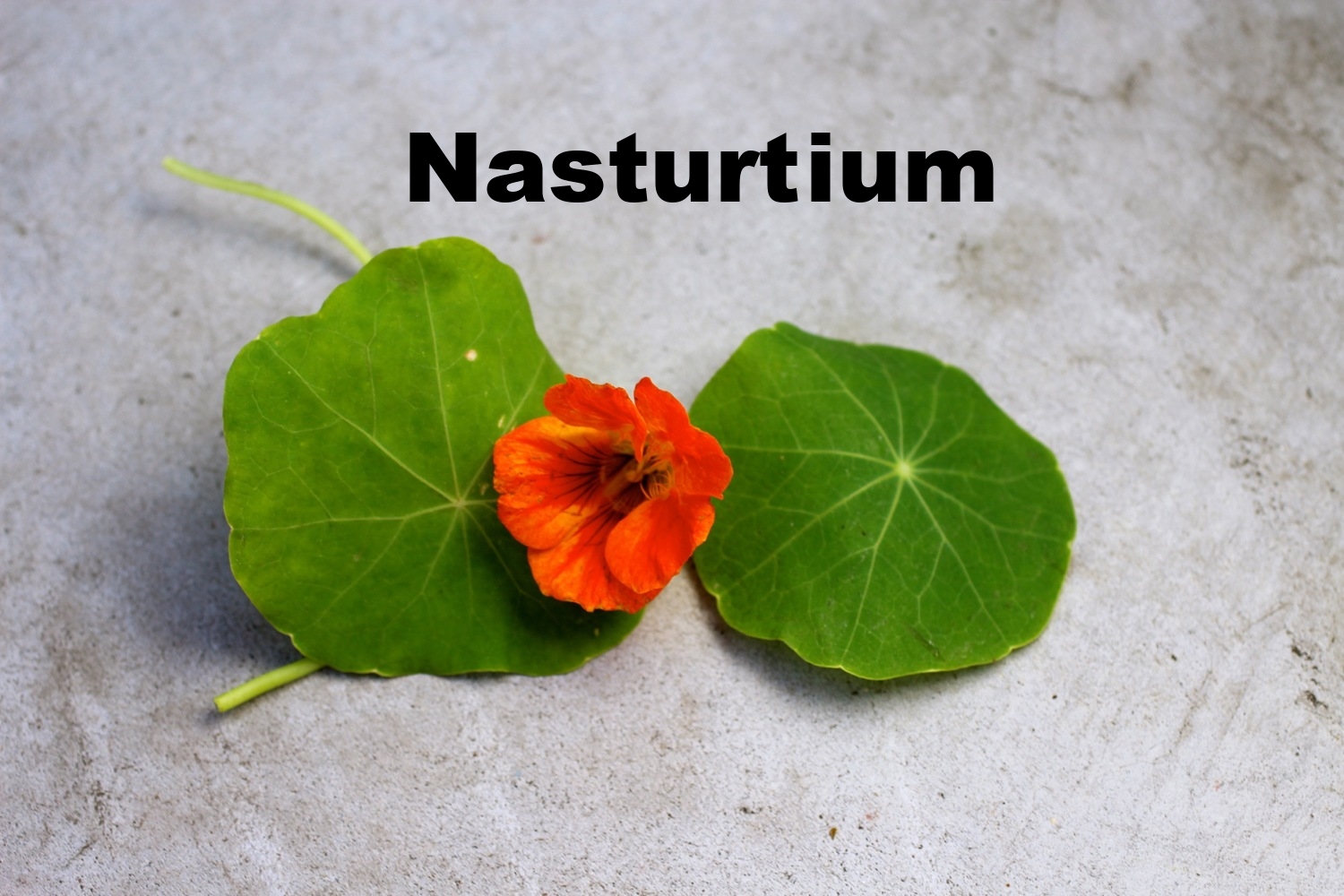



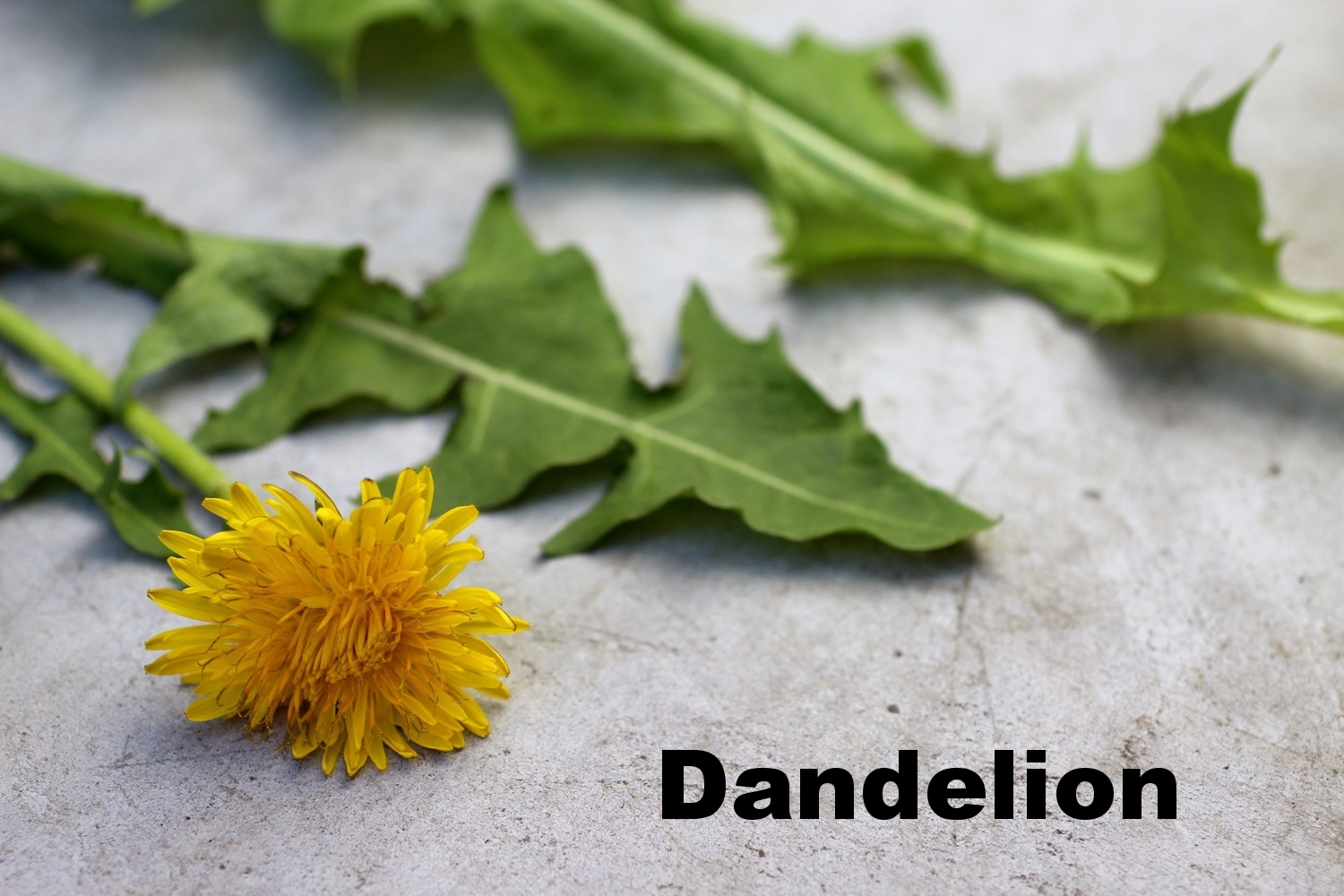




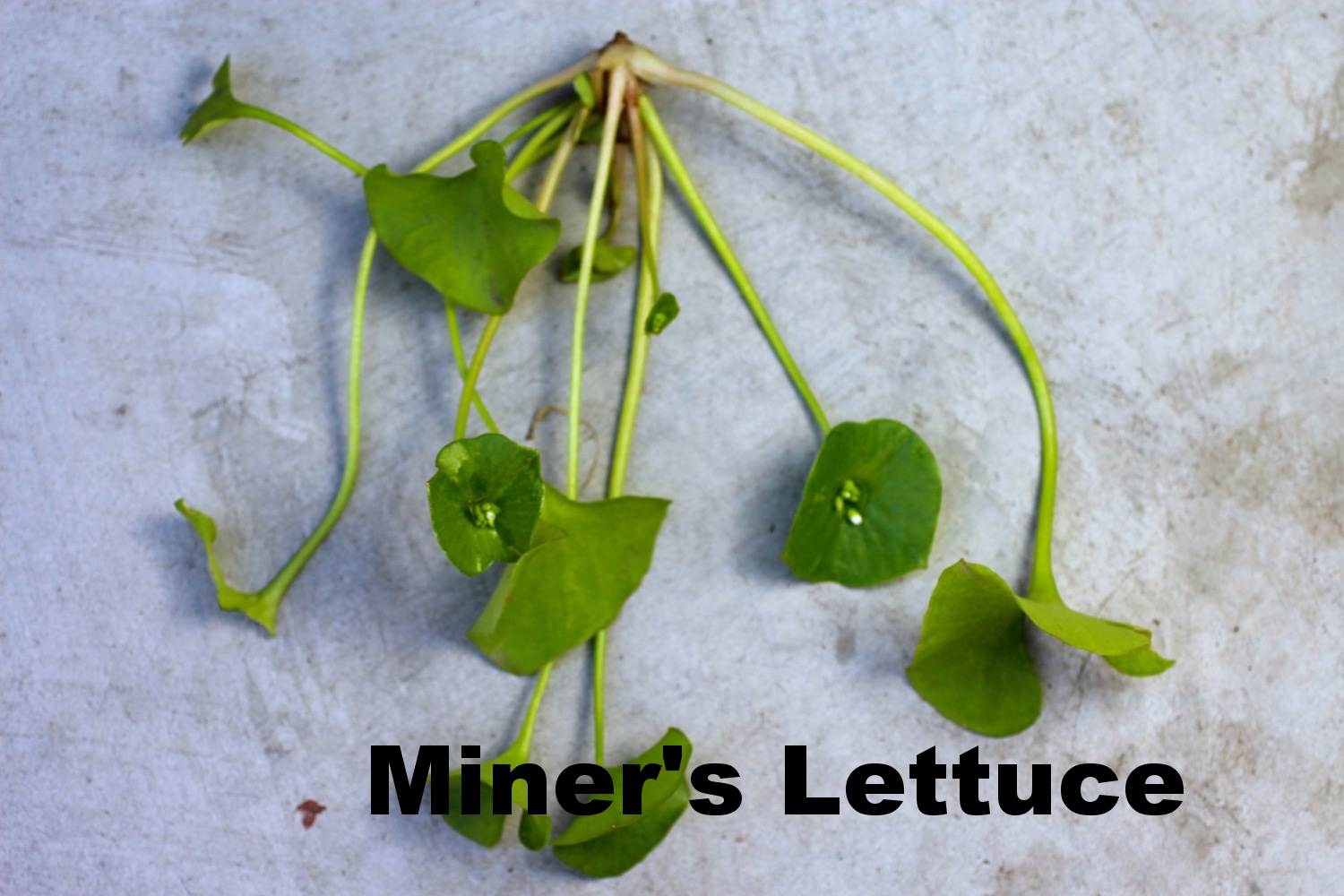

Here's an idea of what the field guide looks like - donate at least $15 to Berkeley Open Source Food and we'll send you one!

We've had a lot of press for this event - check it out!
http://www.eastbayexpress.com/WhatTheFork/archives/2015/03/31/slinging-weeds-wild-food-week
http://us7.campaign-archive2.com/?u=5da7f13757629775a7e122725&id=0b39e78e13&e=d87ccf06ab
http://www.citylab.com/work/2015/04/how-do-you-convince-people-to-eat-weeds/389357/
http://missionlocal.org/2015/04/for-wild-food-week-weeds-for-dinner/
http://www.nbcbayarea.com/news/local/Wild-Food-Week-298812881.html
References:
Gibbons, E., 1962. Stalking the Wild Asparagus, David McKay Co., Inc., NY, 303pp.
Robinson, J. “Breeding the Nutrition Out of Our Food”. The New York Times, 2013.
Craig, W. “Phytochemicals: Guardians of our health.” J Am Diet Assoc. 1997;97:199-204.
Tsukune (Chicken Miso Meatballs) with Nettle Salsa Verde
Izakaya meets foraged greens.

When I have (what I think to be) a unique recipe idea and then find that idea somewhere on the internet, it makes me both happy and sad - happy that the idea is good enough to already be out there and sad that it's already out there. Fortunately, I typically adjust the ingredients enough and add an unusual accompaniment, such as this foraged nettle salsa verde, to make the recipe all my own. The nettle was a volunteer in my snap pea patch and works great as a bright, yet earthy, pairing to the light-bodied and savory tsukune. Remember to be careful when foraging or harvesting stinging nettle - it stays true to its name! Tsukune recipe adapted from here. Serves 4-6.

1 bunch stinging nettles, about 2 cups packed leaves after blanching
1 shallot, chopped
1 clove garlic, chopped
About 1/4 teaspoon sea salt
2-3 tablespoons rice vinegar
1 tablespoon water
1.5 pounds ground chicken, preferably dark meat, divided
1 cup minced scallions (about 4)
1.5 tablespoons white miso
1 tablespoon soy sauce
1 tablespoon brown sugar
1 tablespoon sesame oil
About 1 tablespoon grapeseed or other neutral oil
Shichimi tōgarashi, for garnish
Bring a large pot of water deep enough to submerge the nettles to a boil. Submerge the nettles and cook for 3 minutes.
While nettles are cooking, prepare an ice water bath. Transfer the nettles using tongs to the ice water, cool, then drain and squeeze out excess water. Remove very large or tough stems from the nettles, discard, and blend the remaining leaves and smaller stems in food processor until chopped. Add shallot, garlic, and salt and pulse then incorporate vinegar and water until a texture resembles a coarse salsa. Set aside or refrigerate if preparing more than one hour before making meatballs (can be made up to 24 hours in advance).
Heat a small nonstick skillet over medium heat. Add 1 pound ground chicken and cook, stirring frequently breaking apart pieces, until chicken is opaque and just cooked through, about 2 minutes.
Combine cooked chicken, remaining raw chicken, scallions, and miso in a bowl. Mix together with your hands until a homogenized, sticky mixture forms. Divide mixture into 16-20 meatballs of the same size. Whisk together soy sauce, brown sugar, and sesame oil and keep nearby for use in the next step. If your salsa verde is in the refrigerator, this would be a good time to bring it out to allow it to come to room temperature.
Heat enough grapeseed oil in a large sauté pan to lightly coat pan on medium high. Add meatballs and cook on one side for 2-3 minutes until lightly browned. Drizzle half of soy mixture over meatballs then flip, turn down heat and cook another 2-3 minutes, turning occasionally so that all sides are well-cooked.
Serve meatballs over nettle salsa verde with a drizzle of the remaining soy mixture and sprinkling of shichimi tōgarashi.

Moroccan "Chick-Chick" Salad
Chick peas and chickweed unite.

This salad is a fun play on "chickweed" and "chickpeas" blended together with the Moroccan flavors of pomegranate, cumin, and possibly feta.
My list of favorite foraged greens is long, but chickweed *might* be in the top 5. If not the top 5, then definitely the top 10. Lucky for me, it is one of the most abundant "weeds" available and is also drought resistant - armageddon? Sign me up!
In the Bay Area, you'll find chickweed in abundance after rains when the sun inevitably returns and all the greens start poking up. What I love about this wild green is how soft and delicate the greens are, both in flavor and texture, while still having a slight crunch and very fresh flavor.
To identify chickweed, look for a sprawling plant with oval pointed leaves and possibly small white star-shaped flowers. The most obvious identifying characteristics are:
It does not have milky sap
It has one line of hairs on the side of the stem
If you pull gently on the outer part of the stem, it will separate and there will be a thin inner part that does not separate (try a few times, it might take a bit to get the hang of it)
Some recipes call for cooking chickweed, but I think it's best raw or, maybe, slightly wilted over a soup or by the hot chickpeas in this salad. Serves 2.

3/4 cup cooked chick peas
1 tablespoon plus 2 teaspoons olive oil, divided
1/2 teaspoon cumin
Sea salt
1 tablespoon lemon juice
1 teaspoon pomegranate molasses
4 cups chickweed, washed and dried
1-2 ounces crumbled feta (optional)
Heat cast iron with about 2 teaspoons of olive oil on high. When cast iron is hot, add the chickpeas. Cook, stirring periodically, until beans are lightly browned, about 5 minutes. Once cooked, place in bowl and toss with cumin and a few pinches of sea salt.
“The term “chickweed” is based on the fact that chickens love it —- cute!”
Add lemon juice, pomegranate molasses, remaining olive oil, and a pinch of salt to a mason jar. Whisk with a fork or cover jar and shake to combine.
Combine chickpeas with chickweed in a bowl, drizzle with dressing, and top with crumbled feta (if desired). Serve immediately.

Moroccan chick-chick salad with optional feta.
Fresh Crab with Wood Sorrel-Cilantro Sauce
Ocean strawberries meet wild wood sorrel.
Crab season is one of my favorite seasons of the year. I love the fact that we still rely on fishermen and women to brave the seas in order to bring us these delicious crustaceans. Growing up in Humboldt County, my family lived near a crab stand that purported the clever phrase of "ocean strawberries" on their sign and I like to think of them as a cross between this elegant description and giant bugs.
In our house crab alone was special enough and accompaniments didn't go beyond melted butter and crusty bread. Although I still agree that crab is special enough, I wanted to take advantage of the wild wood sorrel prevalent in my neighborhood by making a vibrant and spicy dipping sauce of wood sorrel, cilantro, serrano, and sesame.
“Many plants, including wood sorrel, contain oxalic acid, which can be toxic in large quantities. Remember to enjoy in moderation.”

Wood sorrel looks like clover, but with yellow flowers on long stems. These are the somewhat fleshy flower stems you may have chewed on as a child walking around town (at least I did) to release their sour juices. The juice or ground leaves can be used as a unique way to provide a lemony kick to sauces or as a bright garnish - a little goes a very long way. Wood sorrel is high in Vitamin C and some use the plant medicinally for liver and digestive issues, but these latter benefits are not confirmed by research. The reason why wood sorrel is so lemony is due to its oxalic acid content, which can be toxic if eaten in large quantities and those with kidney or intestinal problems and pregnant women should avoid it. However, other plants contain oxalic acid as well so the general rule of thumb it to eat wood sorrel in moderation, meaning using some in sauce or as a part of a salad or garnish every once in a while is fine, and consume in combination with a balanced diet. There are also no dangerous look alikes for wood sorrel, making it a great foraged food for newbies! The below recipe serves 4.
2-4 fresh crabs (2 for half a crab each, 4 for heavy crab eaters)
1/2 cup wood sorrel leaves
2 serrano peppers, chopped with seeds removed
1 cup cilantro, chopped
Juice from 1/2 lemon
1 tablespoon ponzu (can substitute 1 teaspoon soy sauce + 2 teaspoons water if needed)
1 teaspoon yellow miso
1-2 tablespoons toasted sesame oil
Cooking and cleaning the crab: Go here for more information and step-by-step photos.
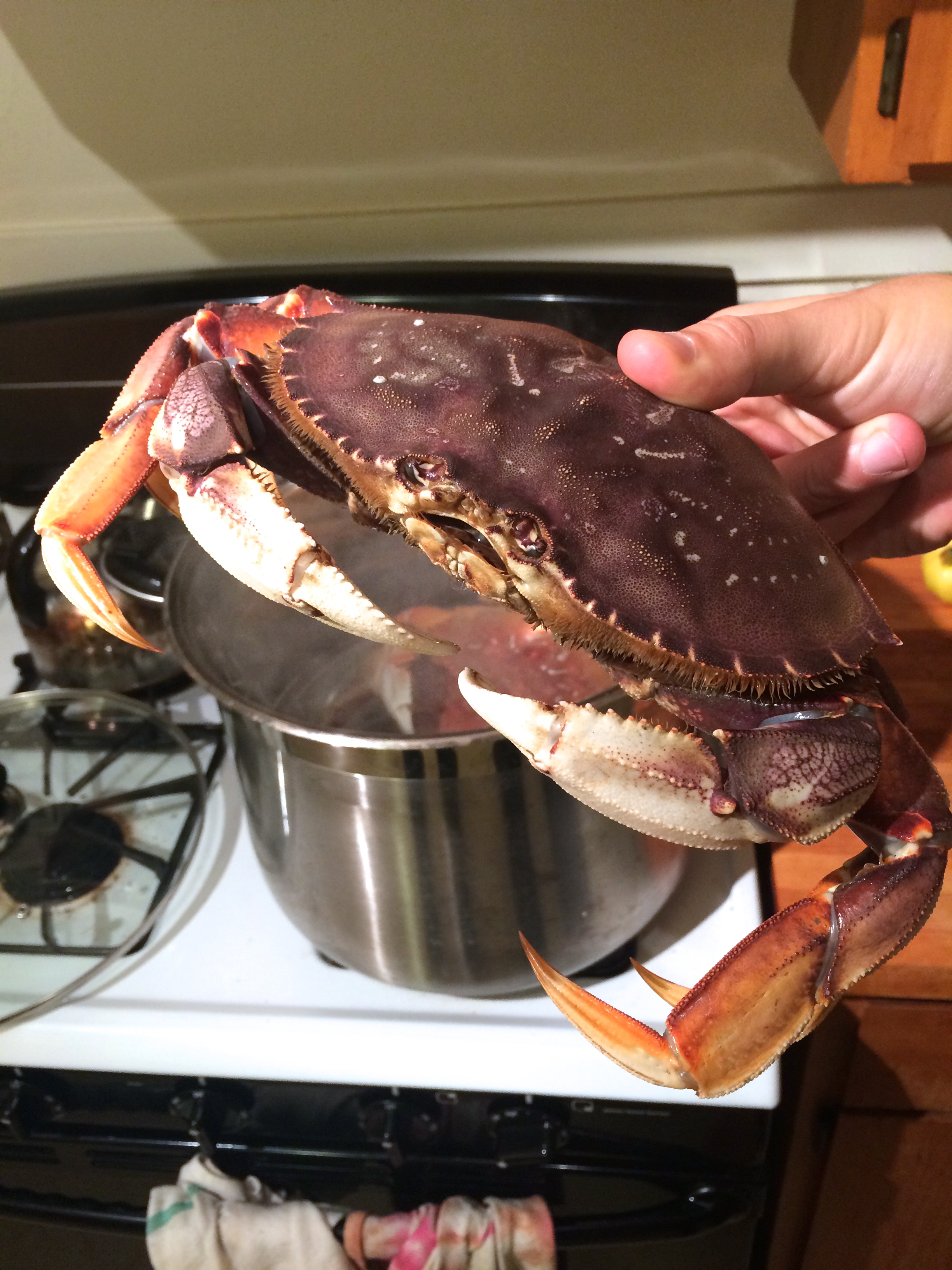
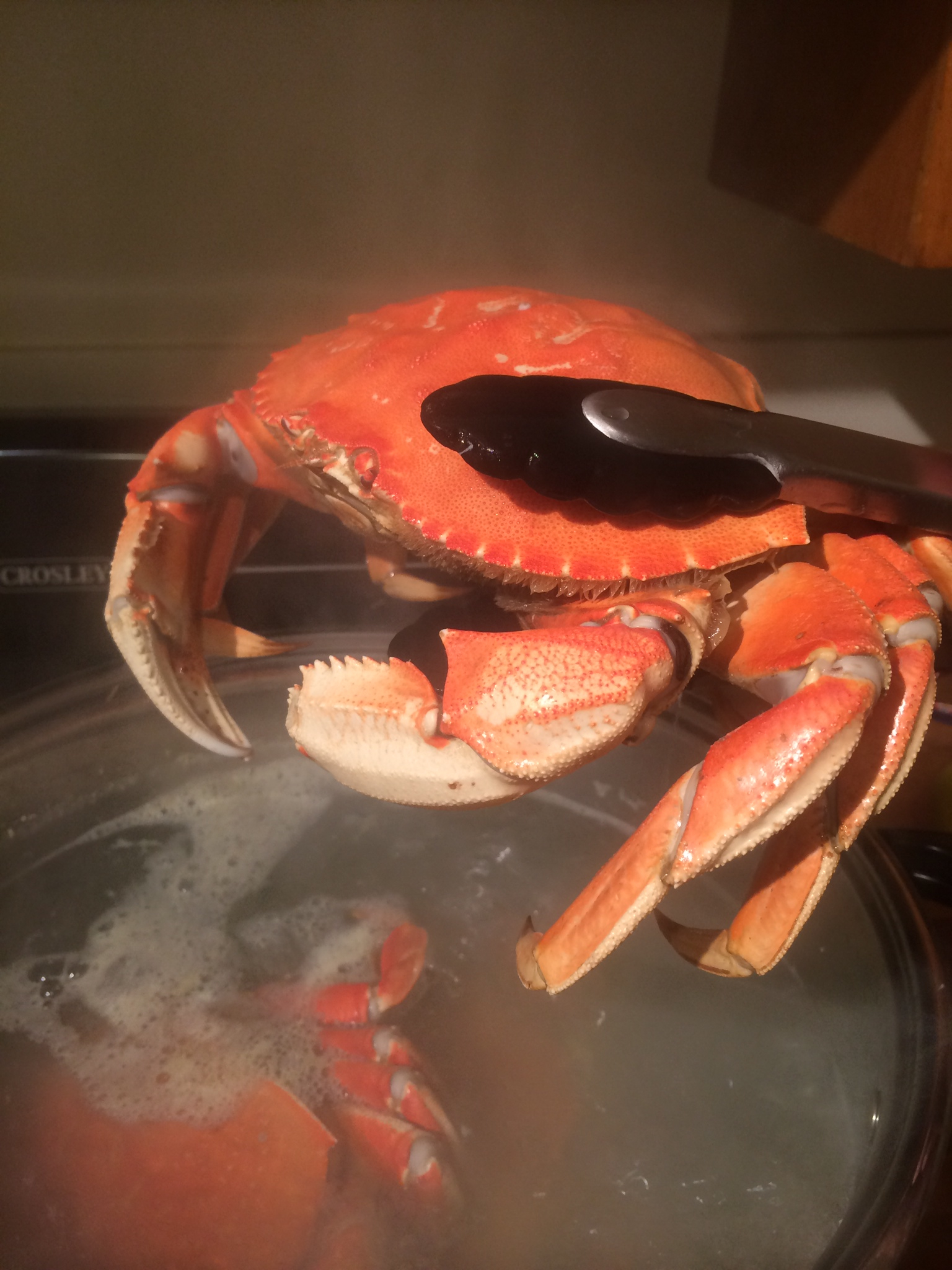
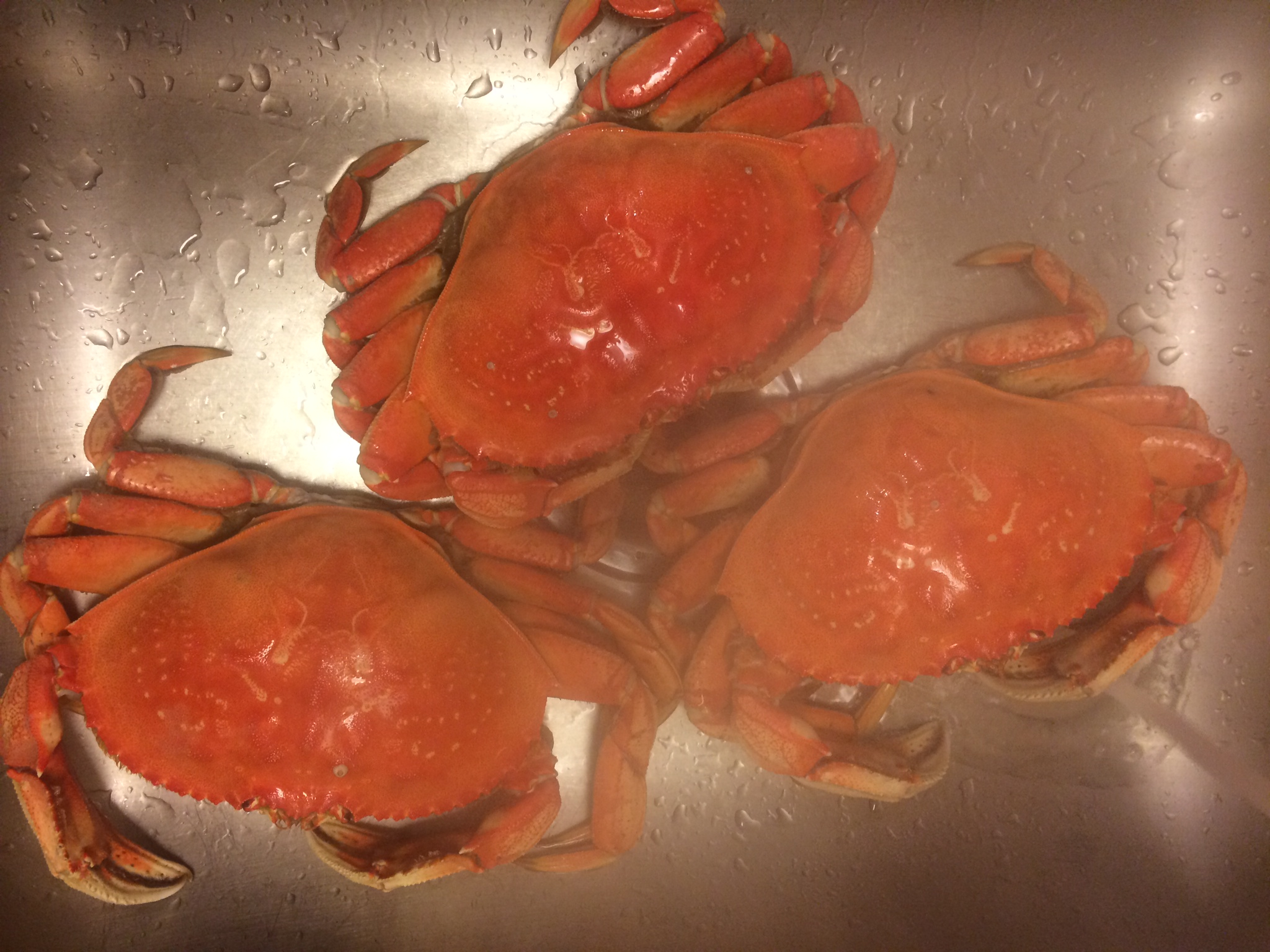
Get a large pot of water to a rolling boil. There should be enough water to cover the crabs. Throw your crabs in and cook them for ~7-8 minutes per pound. That's 7-8 minutes for the average weight of the crabs, not total weight. So, if I have 2 crabs that weigh 1.5 pounds and 2 pounds respectively, I should cook them for about 12-14 minutes. Round down when possible, as you can always cook the crab more if needed, but crab cooking is pretty forgivable. The crabs will change from a purplish color to a bright orange-red.
Remove crabs and rinse under cool water until cool enough to handle.
“Protip: All crabs available to eat are male, as the female are thrown back in to encourage population growth. ”
Turn the crab upside down. Stick your finger underneath the "apron" (little tail looking thing) and pull it off. Remove the carapace (large back shell) by putting finger in hole where apron was and ripping the back shell from the legs. It's actually pretty easy and fun.
Rinse off or save the guts (yellow gushy stuff) found in the carapace. The guts can be eaten on rice, in a stew, or on their own if desired.
Remove the gills (spongy soft jagged things) from either side of the body as well as the mandible (sharp mouthparts in the front).
Give the body a final rinse - remove the greenish-brown and yellow goop - and break the body in half if desired. Serve at room temperature or cold with wood sorrel sauce (below).
To make the wood sorrel sauce: Simply blend all ingredients except sesame oil in a food processor or immersion blender. Drizzle in sesame oil until desired flavor and consistency is achieved.
Here's a quick video demonstrating how to clean a Dungeness Crab:
Foraging Mussels
The easy street to self-sustaining.


If you haven't been mussel foraging, it's easier than you think - I guarantee it. All that it requires is a little bit of forethought, gloves, and a bucket. The last time I went to Baker Beach in San Francisco and there were tons of mussels clinging to a few rocks and our buckets were filled in no time. Yes, the mussels can be a bit rugged in texture, but believe me, they're worth it! Here's what you need to know and do before you forage mussels in California:
Only go during the months from November to April. From May to October mussels are quarantined due to potential paralytic shellfish poisoning - not something you want to mess with.
Call the California Shellfish Biotoxin Information Line at 1-800-553-4133 to double check that waters are safe at the time that you plan to go (sometimes the quarantine for longer periods depending on weather and water conditions).
Stop by a drugstore and pick up a one-day fishing permit or purchase one online from the CA Department of Fish and Wildlife and bring it with you, otherwise you are subject to fines.
Go at low tide: Foraging mussels is best at low tide and mussels can often be found clinging to rocks near the water.
Mussels can only be pulled by hand, do not use other instruments, such as screwdrivers or crowbars.
Bring: Thick gloves, as the mussels can be sharp and a bucket, to hold your booty.
There is a collection limit of 10 pounds (in the shell) per permitted collector per day.
For more information about regulations, visit the CA Department of Fish and Wildlife.




